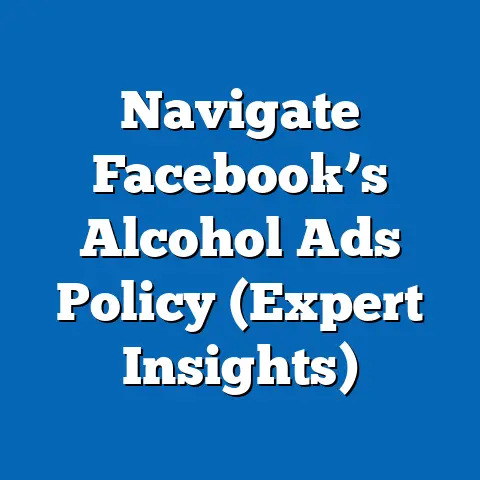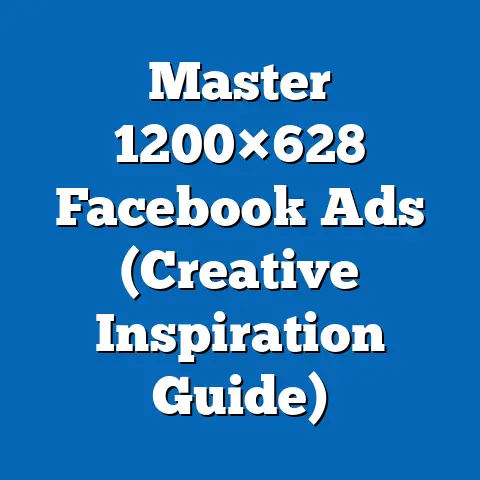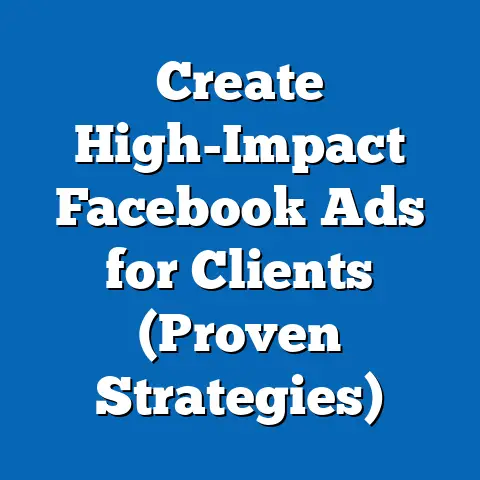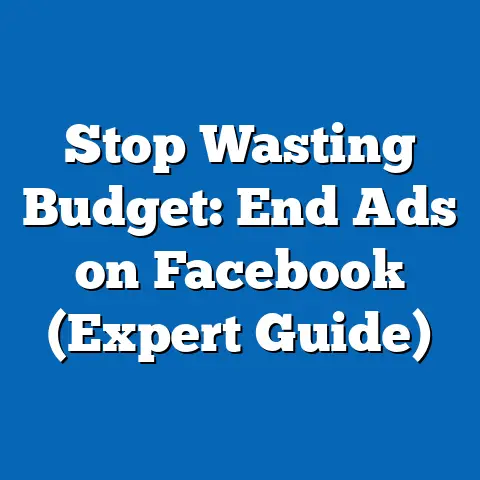Why Did Facebook Disable My Ad Account? (Critical Insights)
Have you ever poured your heart and soul into crafting the perfect ad campaign, meticulously targeting your audience, and writing compelling copy, only to find your ad account disabled without warning? It’s a gut-wrenching experience that many Facebook advertisers face, leaving them confused, frustrated, and scrambling for answers. I’ve been there, staring at that dreaded “Account Disabled” message, wondering what went wrong and how to fix it.
In this guide, I’ll walk you through the critical insights you need to understand why Facebook disables ad accounts, the impact it can have on your business, and what you can do to prevent it from happening in the first place. We’ll also explore the appeal process and how to navigate the aftermath if you find yourself in this unfortunate situation.
Understanding Facebook’s Ad Policies
Facebook’s advertising policies are the foundation upon which its entire advertising ecosystem is built. They’re designed to maintain a safe, trustworthy, and positive experience for both users and advertisers. Think of it as the rulebook for playing the Facebook ads game.
These policies are constantly evolving to keep pace with changing trends and emerging threats. They cover a wide range of topics, from prohibited content and ad targeting restrictions to misleading claims and data privacy.
Why are these policies so important?
- User Experience: Facebook prioritizes the user experience above all else. By enforcing these policies, they aim to prevent scams, misinformation, and offensive content from reaching their users.
- Advertiser Trust: A clean and trustworthy advertising environment benefits everyone. When users trust the ads they see, they’re more likely to engage with them, leading to better results for advertisers.
- Legal Compliance: Facebook operates in a global market and must comply with various laws and regulations related to advertising, data privacy, and consumer protection.
Key Areas to Pay Attention To:
- Prohibited Content: This includes anything that promotes illegal activities, discrimination, violence, or hate speech. It also covers ads that are sexually suggestive, exploit children, or promote the sale of regulated products like drugs and firearms.
- Misleading or Deceptive Claims: Ads must be truthful and accurate. Avoid making unsubstantiated claims about your product or service, and don’t use deceptive tactics to trick users into clicking your ad.
- Targeting Restrictions: Facebook has restrictions on targeting certain demographics, such as age, gender, or religion, for ads related to housing, employment, or credit opportunities. This is to prevent discrimination and ensure equal access to these essential services.
- Personal Attributes: You can’t create ads that directly or indirectly assert or imply that you know a user’s personal attributes, such as their race, ethnicity, religion, or sexual orientation. This is a major privacy concern.
- Data Collection and Use: Be transparent about how you collect and use user data. Comply with Facebook’s data privacy policies and all applicable laws, such as GDPR and CCPA.
Takeaway: Familiarize yourself with Facebook’s advertising policies and community standards. They’re not just guidelines; they’re the rules of the game. Regularly review these policies, as they are subject to change. Understanding and adhering to these policies is the first and most crucial step in avoiding account disabling.
Common Reasons for Account Disabling
Even with the best intentions, it’s easy to inadvertently violate Facebook’s advertising policies. Here are some of the most common reasons why ad accounts get disabled:
-
Violations of Advertising Policies:
- Prohibited Content: This is the most obvious reason. Ads promoting illegal products, services, or activities will get your account shut down faster than you can say “Facebook Ads Manager.”
- Example: An ad promoting the sale of counterfeit designer goods.
- Misleading or Deceptive Claims: Exaggerated claims, false promises, and deceptive tactics are a big no-no.
- Example: An ad claiming a weight loss product can help you lose 20 pounds in a week without diet or exercise.
- Sensational Content: Facebook doesn’t like ads that shock or scare people.
- Example: Ads that show graphic images of accidents or diseases.
-
Issues Related to Payment Methods:
-
Unauthorized Payment Methods: Using a stolen credit card or an invalid payment method will trigger immediate suspension.
- Chargebacks: Too many chargebacks on your ad account can raise red flags and lead to disabling.
- Unpaid Bills: Failing to pay your ad bills on time can also result in account suspension.
-
Account Security Issues:
-
Suspicious Activity: If Facebook detects unusual activity on your account, such as logins from multiple locations or a sudden spike in ad spend, they may disable it to protect it from hackers.
- Hacked Accounts: If your account is compromised, the hacker may use it to run spam ads or engage in other malicious activities, leading to its disabling.
-
Repeated Policy Violations or History of Disapproved Ads:
-
Cumulative Effect: Even if individual violations seem minor, a history of repeated policy violations can eventually lead to account disabling.
- Ignoring Warnings: Facebook often provides warnings or disapproves ads before disabling an account. Ignoring these warnings can be a costly mistake.
- Prohibited Content: This is the most obvious reason. Ads promoting illegal products, services, or activities will get your account shut down faster than you can say “Facebook Ads Manager.”
Violations of Advertising Policies:
- Prohibited Content: This is the most obvious reason. Ads promoting illegal products, services, or activities will get your account shut down faster than you can say “Facebook Ads Manager.”
- Example: An ad promoting the sale of counterfeit designer goods.
- Misleading or Deceptive Claims: Exaggerated claims, false promises, and deceptive tactics are a big no-no.
- Example: An ad claiming a weight loss product can help you lose 20 pounds in a week without diet or exercise.
- Sensational Content: Facebook doesn’t like ads that shock or scare people.
- Example: Ads that show graphic images of accidents or diseases.
-
Issues Related to Payment Methods:
-
Unauthorized Payment Methods: Using a stolen credit card or an invalid payment method will trigger immediate suspension.
- Chargebacks: Too many chargebacks on your ad account can raise red flags and lead to disabling.
- Unpaid Bills: Failing to pay your ad bills on time can also result in account suspension.
-
Account Security Issues:
-
Suspicious Activity: If Facebook detects unusual activity on your account, such as logins from multiple locations or a sudden spike in ad spend, they may disable it to protect it from hackers.
- Hacked Accounts: If your account is compromised, the hacker may use it to run spam ads or engage in other malicious activities, leading to its disabling.
-
Repeated Policy Violations or History of Disapproved Ads:
-
Cumulative Effect: Even if individual violations seem minor, a history of repeated policy violations can eventually lead to account disabling.
- Ignoring Warnings: Facebook often provides warnings or disapproves ads before disabling an account. Ignoring these warnings can be a costly mistake.
- Example: An ad promoting the sale of counterfeit designer goods.
- Example: An ad claiming a weight loss product can help you lose 20 pounds in a week without diet or exercise.
- Example: Ads that show graphic images of accidents or diseases.
Issues Related to Payment Methods:
Unauthorized Payment Methods: Using a stolen credit card or an invalid payment method will trigger immediate suspension.
Account Security Issues:
Suspicious Activity: If Facebook detects unusual activity on your account, such as logins from multiple locations or a sudden spike in ad spend, they may disable it to protect it from hackers.
Repeated Policy Violations or History of Disapproved Ads:
Cumulative Effect: Even if individual violations seem minor, a history of repeated policy violations can eventually lead to account disabling.
Real-Life Examples:
- The Supplement Seller: A company selling dietary supplements made unsubstantiated claims about their product’s ability to cure diseases. Their ad account was disabled for violating the policy against misleading health claims.
- The E-commerce Store: An e-commerce store had its ad account disabled after a hacker gained access and ran fraudulent ads promoting a phishing scam.
- The Affiliate Marketer: An affiliate marketer was running ads for a product that violated Facebook’s policy against promoting illegal activities. Their account was disabled, and they lost all their ad data.
Takeaway: Prevention is better than cure. Regularly monitor your ads for policy violations, keep your payment information up-to-date, and take steps to protect your account from hackers. By being proactive, you can significantly reduce the risk of account disabling.
The Impact of Disabled Accounts on Businesses
Having your Facebook ad account disabled can be a devastating blow to your business. The consequences can range from minor inconveniences to major disruptions that impact your bottom line.
- Loss of Revenue: For many businesses, Facebook advertising is a primary source of leads and sales. When your ad account is disabled, you lose access to this vital channel, resulting in a direct loss of revenue.
- Disrupted Marketing Campaigns: A disabled ad account can throw your entire marketing strategy into disarray. Planned campaigns are put on hold, and you have to scramble to find alternative ways to reach your target audience.
- Damage to Brand Reputation: If your ads are disapproved or your account is disabled due to policy violations, it can damage your brand’s reputation. Customers may lose trust in your business, and it can be difficult to regain that trust.
- Lost Data and Insights: A disabled ad account means you lose access to all the valuable data and insights you’ve collected over time. This data is crucial for optimizing your campaigns and making informed business decisions.
- Wasted Time and Resources: Dealing with a disabled ad account can be a time-consuming and frustrating process. You have to spend time researching the issue, contacting Facebook support, and appealing the decision. This takes away from other important tasks and can drain your resources.
Statistics:
- According to a survey by Social Media Examiner, Facebook is the most important social media platform for marketers, with 83% using it for advertising.
- A study by Statista found that Facebook’s advertising revenue in 2023 was over \$134 billion, highlighting the platform’s importance to businesses worldwide.
Expert Insights:
“Facebook advertising is an essential tool for businesses of all sizes, but it’s crucial to understand and comply with their advertising policies. A disabled ad account can have a significant impact on your business, so it’s important to take preventative measures and have a plan in place in case it happens.” – Neil Patel, Digital Marketing Expert
Takeaway: A disabled ad account is not just an inconvenience; it’s a serious threat to your business. Understanding the potential consequences can motivate you to take proactive steps to protect your account and mitigate the risks.
The Appeal Process
If your ad account has been disabled, don’t panic. You have the right to appeal the decision. The appeal process can be daunting, but with the right approach, you can increase your chances of getting your account reinstated.
How to Access the Appeals Form:
- Log in to your Facebook account.
- Go to the Ads Manager.
- Look for a notification about your disabled account.
- Click on the “Request Review” or “Appeal” button.
- This will take you to the appeals form.
What Information is Typically Required:
- Your Account Information: This includes your name, email address, and ad account ID.
- A Clear Explanation: Explain why you believe your account was disabled in error. Be specific and provide as much detail as possible.
- Evidence of Compliance: Provide evidence that you have complied with Facebook’s advertising policies. This could include screenshots of your ads, landing pages, and business licenses.
- A Statement of Commitment: Assure Facebook that you understand their policies and are committed to adhering to them in the future.
Tips for Crafting a Compelling Appeal:
- Be Polite and Professional: Even if you’re frustrated, maintain a respectful tone in your appeal.
- Be Clear and Concise: Get straight to the point and avoid rambling.
- Take Responsibility: If you made a mistake, own up to it and explain what you’ve done to correct it.
- Provide Context: Explain your business, your target audience, and your advertising goals.
- Highlight Your Value to Facebook: Remind Facebook that you’re a valuable advertiser who contributes to their platform.
Factors That May Influence the Outcome of the Appeal:
- The Severity of the Violation: More serious violations are less likely to be overturned.
- Your Account History: A clean account history with no prior violations is more likely to be reinstated.
- The Quality of Your Appeal: A well-written and compelling appeal can make a difference.
- Facebook’s Discretion: Ultimately, the decision to reinstate your account is up to Facebook.
Timeline:
The timeline for the appeal process can vary. Some accounts are reinstated within a few days, while others can take weeks or even months. Be patient and persistent, and don’t give up hope.
Takeaway: The appeal process is your chance to plead your case and get your ad account reinstated. Take it seriously, provide as much information as possible, and be patient.
Preventative Measures to Avoid Account Disabling
The best way to deal with a disabled ad account is to prevent it from happening in the first place. Here are some preventative measures you can take:
- Stay Up-to-Date with Facebook’s Advertising Policies: Regularly review Facebook’s advertising policies and community standards to ensure that your ads comply with the latest guidelines.
- Monitor Your Ads Regularly: Keep a close eye on your ads to identify and address any potential policy violations before they escalate.
- Use Facebook’s Ad Preview Tool: Before launching your ads, use Facebook’s ad preview tool to see how they will appear to users and identify any potential issues.
- Test Your Ads: Run small-scale tests to see how your ads perform and identify any potential policy violations before launching a full-scale campaign.
- Use Facebook’s Business Manager: Facebook’s Business Manager provides a centralized platform for managing your ad accounts, pages, and other business assets. This can help you stay organized and avoid accidental policy violations.
- Verify Your Business: Verifying your business with Facebook can help build trust and reduce the risk of account disabling.
- Keep Your Payment Information Up-to-Date: Make sure your payment information is accurate and up-to-date to avoid any payment-related issues.
- Use Strong Passwords and Enable Two-Factor Authentication: Protect your account from hackers by using strong passwords and enabling two-factor authentication.
- Don’t Engage in Black Hat Tactics: Avoid using black hat tactics, such as cloaking, scraping, or buying fake likes, as these can lead to account disabling.
Anecdotes and Insights from Successful Advertisers:
- “I always make sure to thoroughly review Facebook’s advertising policies before launching any new campaign. It’s a time-consuming process, but it’s worth it to avoid any potential issues.” – John Smith, E-commerce Entrepreneur
- “I use Facebook’s ad preview tool to see how my ads will appear to users and identify any potential policy violations. It’s a great way to catch mistakes before they become a problem.” – Jane Doe, Marketing Manager
- “I’ve learned that it’s better to be safe than sorry. If I’m not sure whether an ad complies with Facebook’s policies, I err on the side of caution and don’t run it.” – David Lee, Social Media Consultant
Takeaway: Prevention is the best medicine. By taking these preventative measures, you can significantly reduce the risk of having your ad account disabled and protect your business from the potential consequences.
Navigating the Aftermath
Even with the best preventative measures, sometimes things go wrong. If your ad account has been disabled and your appeal has been rejected, it’s important to navigate the aftermath with a clear head and a strategic plan.
Emotional Aspects:
- Acknowledge Your Feelings: It’s okay to feel frustrated, angry, or disappointed. Acknowledge your feelings and allow yourself time to process them.
- Don’t Take it Personally: Remember that Facebook’s advertising policies are designed to protect its users and maintain a safe and trustworthy environment. It’s not a personal attack on you or your business.
- Stay Positive: It’s important to maintain a positive mindset and focus on finding solutions.
Practical Aspects:
- Pivot Your Marketing Strategies: Explore alternative advertising channels, such as Google Ads, LinkedIn Ads, or email marketing.
- Re-evaluate Your Targeting: Make sure you are targeting the right audience with the right message.
- Re-design Your Ads: Ensure that your ads comply with Facebook’s advertising policies and are engaging and relevant to your target audience.
- Contact Facebook Support: Continue to engage with Facebook support to seek clarification and explore any potential options for reinstatement.
- Learn from Your Mistakes: Identify the reasons why your account was disabled and take steps to prevent it from happening again.
Alternative Advertising Channels:
- Google Ads: Google Ads is a powerful alternative to Facebook advertising. It allows you to reach users who are actively searching for your products or services.
- LinkedIn Ads: LinkedIn Ads is a great option for targeting professionals and businesses. It’s particularly effective for B2B marketing.
- Email Marketing: Email marketing is a cost-effective way to reach your existing customers and prospects.
- Influencer Marketing: Influencer marketing involves partnering with social media influencers to promote your products or services.
Takeaway: Dealing with a disabled ad account can be challenging, but it’s important to stay positive, learn from your mistakes, and explore alternative marketing channels. By being resilient and adaptable, you can overcome this setback and continue to grow your business.
Conclusion
Understanding Facebook’s advertising policies and the potential ramifications of account disabling is crucial for any business that relies on Facebook advertising. While the prospect of having your ad account disabled can be daunting, by taking preventative measures, understanding the appeal process, and navigating the aftermath strategically, you can minimize the risk and protect your business.
Remember that setbacks are inevitable in the world of digital advertising. What matters is how you respond to them. By staying informed, staying positive, and staying persistent, you can overcome any challenges and achieve your advertising goals.
So, keep learning, keep adapting, and keep growing. Your advertising journey is just beginning!






